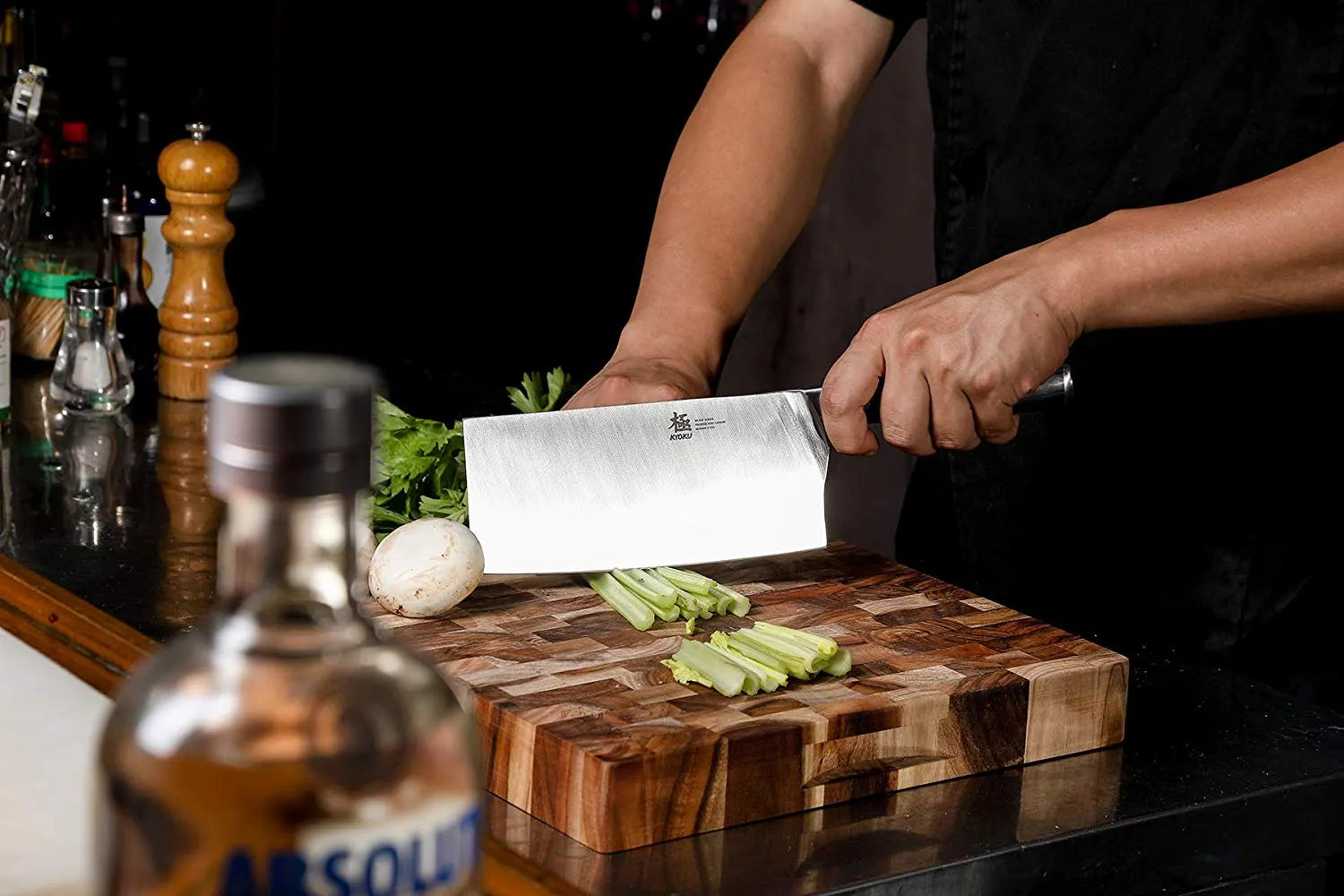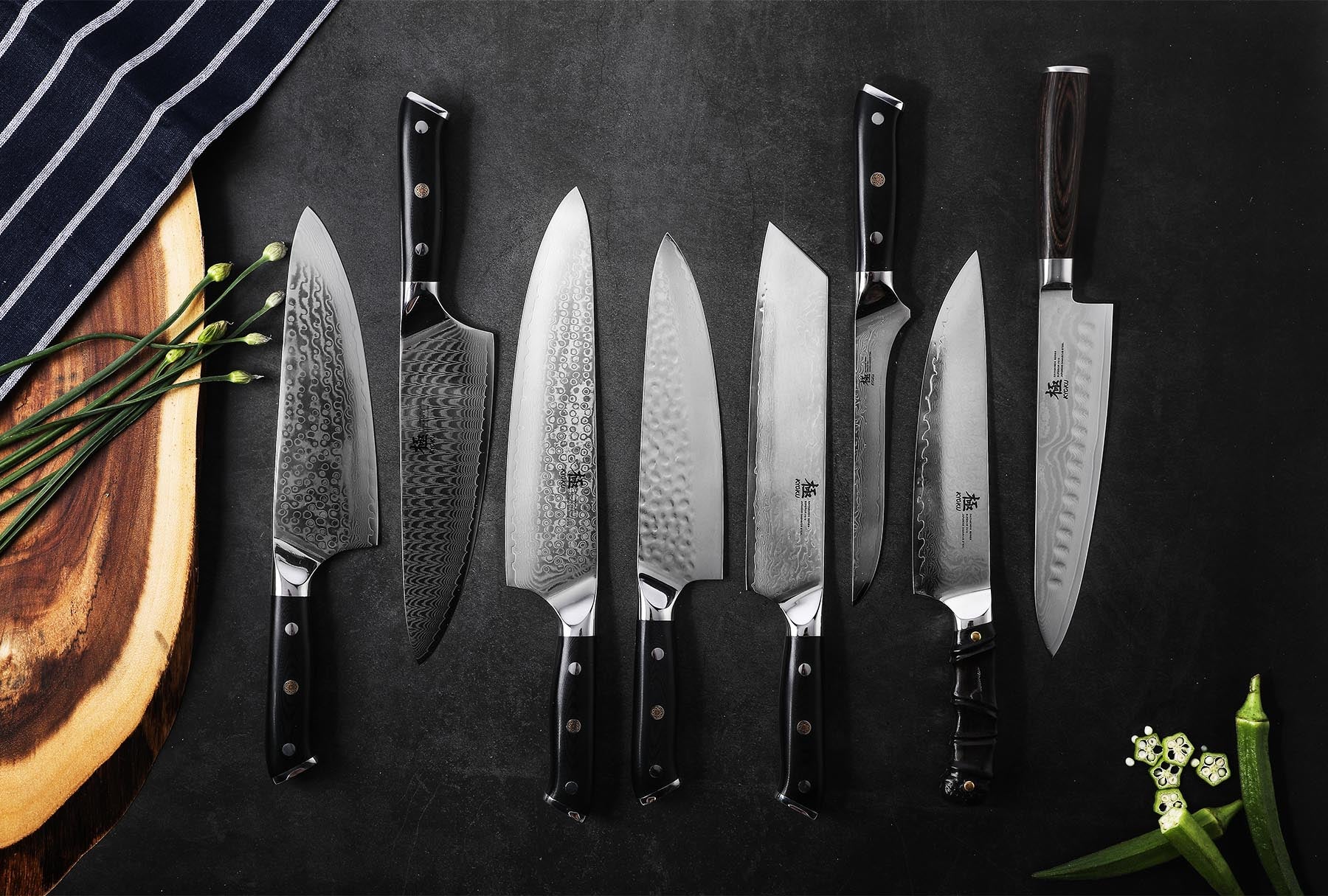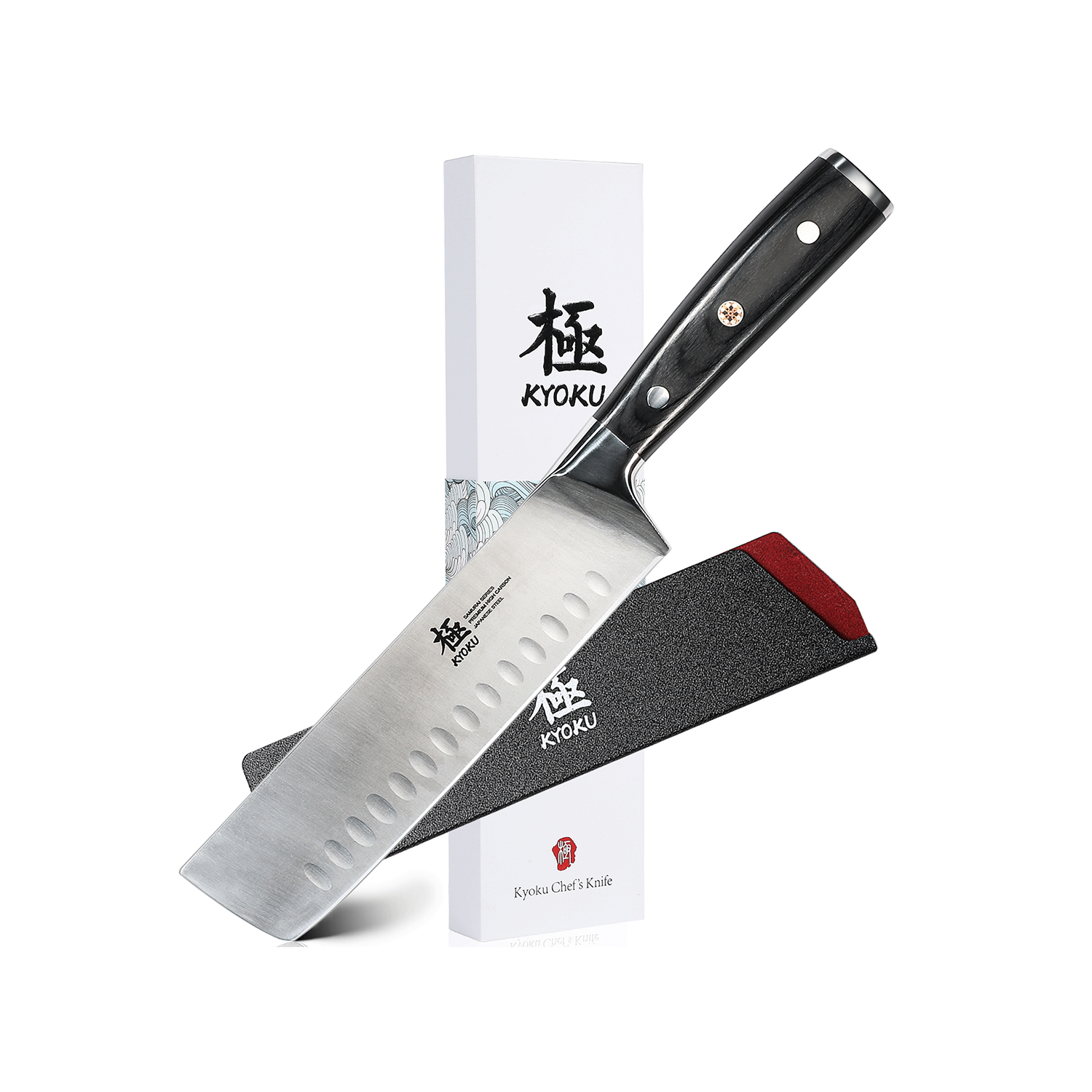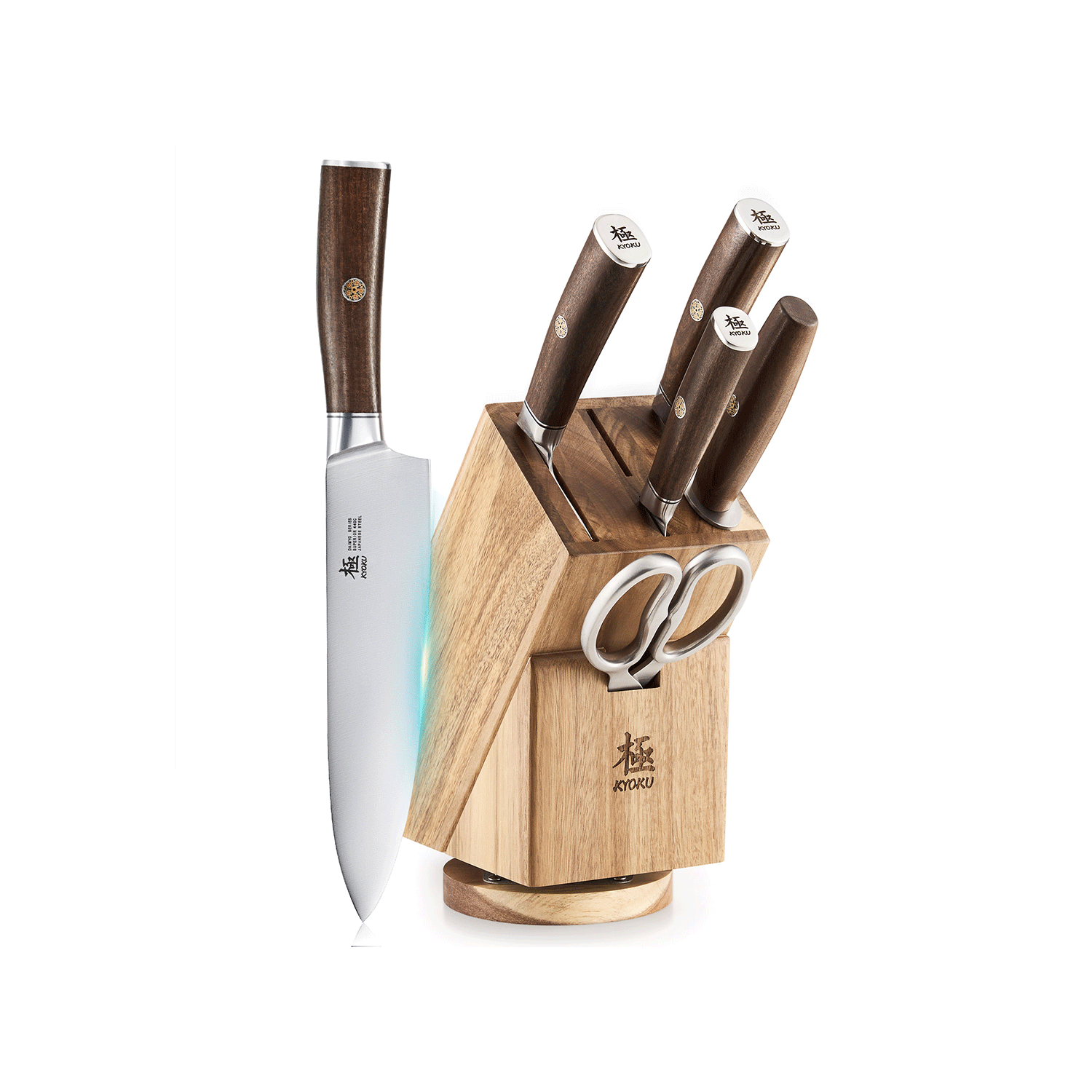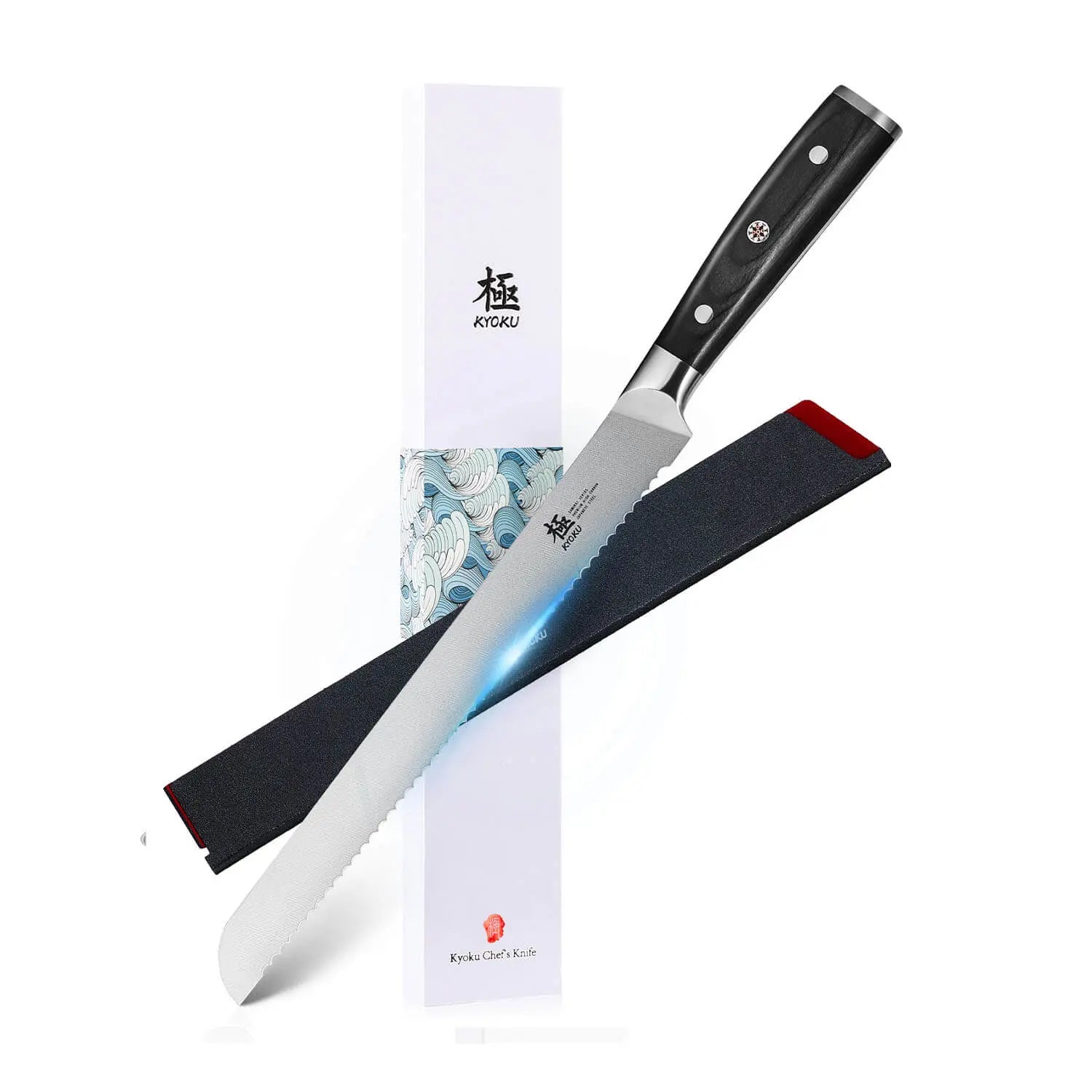In the realm of culinary tools, few knives command attention and respect quite like the mighty cleaver knife. With its robust build and formidable presence, the cleaver knife is a kitchen essential that embodies both power and precision. In this blog, we will explore the world of cleaver knives, their purpose, their differences from butcher knives, the best options available, and how to skillfully wield one. So, let's dive into the fascinating realm of the cleaver knife!
What is a Cleaver Knife Used For?
- The cleaver knife, also known as a meat cleaver, is a versatile cutting instrument primarily used for handling large cuts of meat.
- Its broad, thick blade and sturdy construction make it ideal for tasks such as chopping bones, breaking down poultry, and tenderizing tough cuts of meat.
- However, its applications extend beyond meat preparation, as it can also excel at smashing garlic, crushing spices, and even mincing herbs with finesse.
The Best Cleaver Knives to Choose
When it comes to selecting the best cleaver knives, several exceptional options stand out. These knives have garnered praise for their quality craftsmanship, durability, and superior performance in the kitchen.
Here are six top contenders for the title of best cleaver knife:
1. Kyoku Knives 7-inch cleaver
The 7 inch cleaver knife from Kyoku Knives is a remarkable embodiment of power, precision, and exquisite craftsmanship. Designed to handle heavy-duty cutting tasks with ease, this cleaver is a culinary workhorse that excels in both professional and home kitchens. With its exceptional quality and thoughtful design, the Kyoku cleaver is a testament to the brand's commitment to delivering top-notch cutlery.
2. Wusthof Classic 7 inch Cleaver
Renowned for their precision and German engineering, Wusthof knives are a staple in many kitchens. The Wusthof Classic 7 inch Cleaver boasts a full-tang construction, a high-carbon stainless steel blade, and a comfortable handle. Its versatile design allows for effortless chopping, mincing, and slicing, making it a favorite among both professional chefs and home cooks.
3. Shun Classic 7 inch Vegetable Cleaver
Shun knives are acclaimed for their exquisite craftsmanship and exceptional sharpness. The Shun Classic 7-inch Vegetable Cleaver is no exception. With its Damascus-clad stainless steel blade and D-shaped PakkaWood handle, this cleaver offers precise control and effortless cutting. Its wider blade excels at slicing through fruits, vegetables, and boneless meats.
4. Zwilling J.A. Henckels Twin Signature 7 inch Vegetable Cleaver
Zwilling J.A. Henckels is a trusted name in the culinary world, and their Twin Signature 7-Inch Vegetable Cleaver showcases their dedication to quality. Crafted from high-carbon stainless steel, this cleaver features a comfortable handle and a sturdy, sharp blade. Its versatility shines in tasks such as chopping, dicing, and smashing garlic.
5. Dalstrong Gladiator Series 7 inch Cleaver
The Dalstrong Gladiator Series combines exceptional performance with striking aesthetics. The 7-inch Cleaver from this series features a precision-forged, high-carbon German steel blade, meticulously tapered for improved flexibility and minimal slicing resistance. The ergonomic handle ensures comfort and control during use, making it a reliable tool for heavy-duty tasks.
6. Mercer Culinary Genesis 6 inch Forged Cleaver
Mercer Culinary offers professional-grade knives at an affordable price point, and their Genesis 6-Inch Forged Cleaver is a standout option. This cleaver is forged from high-carbon, stain-resistant German steel and features a comfortable Santoprene handle. Its smaller size makes it suitable for both home and professional kitchens, providing excellent maneuverability without compromising power.
Remember, choosing the best cleaver knife ultimately depends on your personal preferences and specific needs in the kitchen. Consider factors such as blade material, handle comfort, and intended use to find the cleaver knife that perfectly complements your culinary journey.
How to Use a Cleaver Knife
1. Grip the handle: Hold the cleaver firmly with a secure grip on the handle. Ensure your hand is positioned comfortably and securely to maintain control during use.
2. Choose the right cutting surface: Place a sturdy cutting board or surface that can withstand the force of the cleaver. A wooden or plastic cutting board is recommended to avoid damaging the blade.
3. Position the ingredient: Place the ingredient you want to cut or chop on the cutting board. Ensure it is stable and won't move around during the cutting process.
4. Determine the cutting technique: Depending on the task at hand, there are a few different cutting techniques you can employ with a cleaver:
Chopping: For larger, thicker cuts, position the cleaver's blade on the desired cutting line and bring it down with force to chop through the ingredients. Use a steady, controlled motion.
Rocking motion: For smaller, more precise cuts, use a rocking motion with the cleaver. Hold the handle and use the blade tip to rock back and forth, slicing through the ingredients. This technique is useful for mincing or fine-chopping ingredients.
Smashing: In some cases, you may want to use the flat side of the cleaver's blade to smash ingredients like garlic or ginger. Hold the handle firmly, position the flat side of the blade over the ingredient, and apply downward force to crush it.
5. Apply downward force: Depending on your technique, apply controlled downward force to the cleaver using your hand and arm strength. Be mindful of the amount of force required and adjust accordingly to ensure safe and efficient cutting.
6. Repeat if necessary: If you're working through a larger piece of meat or a large quantity of ingredients, you may need to repeat the cutting motion multiple times to achieve the desired results. Take breaks as needed to prevent fatigue.
7. Clean and maintain: After use, clean the cleaver with warm, soapy water and dry it thoroughly. Store it in a safe place, keeping the blade protected to maintain its sharpness. Regularly sharpen the cleaver to ensure optimal cutting performance.
When it comes to cleaver knives, many people often draw comparisons to butcher knives. However, it's not always easy to discern the differences between these two types of knives. In this guide, we aim to provide users with valuable insights into the distinguishing features of cleaver knives and butcher knives, aiding them in making informed choices based on their specific needs and preferences. By highlighting the unique characteristics of each knife, we hope to empower users to select the tool that best suits their culinary requirements.
Cleaver Knife VS Butcher knife
The differences between a cleaver and a butcher knife lie in their design, intended use, and functionality.
1. Blade Shape and Thickness:
Cleaver Knife: A cleaver typically has a wide, rectangular-shaped blade with a thick spine. This design provides weight and strength, making it suitable for heavy-duty tasks like chopping through bones and tough cuts of meat. The flat side of the blade can also be used for crushing garlic or ginger.
Butcher Knife: A butcher knife has a narrower, curved blade with a pointed tip. The blade is often thinner compared to a cleaver, allowing for precise slicing, trimming, and portioning of meat. The curved shape aids in controlled cuts and facilitates maneuverability.
2. Purpose and Function:
Cleaver Knife: Cleavers are primarily used for heavy chopping and cutting tasks, particularly in butchery. They excel at breaking down large cuts of meat, cleaving through bones, and handling tough, fibrous ingredients. Cleavers are also versatile enough to be used for smashing garlic or ginger and can handle tasks beyond meat preparation.
Butcher Knife: Butcher knives are more versatile and commonly used for a variety of meat preparation tasks. They are ideal for trimming fat, removing silverskin, deboning, portioning meat, and making precise cuts. Butcher knives offer greater control and finesse when compared to cleavers.
3. Weight and Handling:
Cleaver Knife: Cleavers are generally heavier due to their thick, solid construction. The weight of a cleaver provides momentum and power for chopping through bones and tough materials. However, this weight can require more effort to handle, particularly during prolonged use.
Butcher Knife: Butcher knives are typically lighter in weight, offering better maneuverability and control. The lighter build allows for increased precision when making intricate cuts and performing tasks that require finer control.
4. Culinary Applications:
Cleaver Knife: Cleavers are well-suited for heavy chopping and cleaving tasks in meat preparation. They are commonly used in Asian cuisine for tasks like breaking down poultry, chopping through bones, and preparing large cuts of meat. Cleavers can also be used for crushing spices or chopping hard vegetables.
Butcher Knife: Butcher knives are versatile tools used in various aspects of meat preparation. They are essential for tasks such as trimming, portioning, deboning, and slicing meat. Butcher knives are widely used in professional kitchens and are suitable for both precision and larger cutting tasks.
In summary, cleavers are heavy-duty knives designed for chopping and cutting through tough materials, while butcher knives offer precision and versatility for a range of meat preparation tasks. Consider the specific requirements of your culinary endeavors to determine which knife would best suit your needs.
Recommend Cleaver Knives for You
Check Out Our 3 Popular Collections
Subscribe for Newsletter to Get 10% Off
The latest news, events and stories delivered right to your inbox



